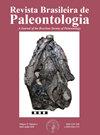New occurrences of Amiidae (Halecomorphi: Amiiformes: Vidalamiinae) from the Bauru Group (Late Cretaceous, Brazil) and comments about their incursion in freshwater environments in the Cretaceous of the Americas
IF 0.6
4区 地球科学
Q4 PALEONTOLOGY
引用次数: 2
Abstract
The Late Cretaceous continental deposits of the Bauru Group of Brazil have a rich vertebrate fossil fauna, but studies on the fossil fishes from the unit are scarce. This paper describes new occurrences of the Vidalamiinae subfamily of the bony fish group Amiidae (Halecomorphi: Amiiformes). The new occurrences are comprised by three isolated vertebral centra and three isolated teeth from the Marília and Adamantina formations, which were collected in Uberaba and Prata municipalities. The fossils described here not only expand the record of Vidalamiinae for the Bauru Group, but also clarify that the assignment of isolated teeth to this group may now be done with more certainty, which was not the case in many previous studies. Additionally, we also refer the described specimens tentatively to the Vidalamiini, which is the first assignment to this group and to the tribe level for any fish material from the Bauru Group. This study also offers an overview on the paleobiogeography of the Amiidae during the Late Cretaceous and an updated compilation of vidalamiine records during the Cretaceous, with a special focus on the freshwater records of this originally saltwater group. Finally, we also discuss the distribution of the tribes Vidalamiini and Calamopleurini during the Late Cretaceous, and the possibility that the North American and South American vidalamiines may have dispersed between the continents through a land connection. Keywords: Amiiformes, Amiidae, Vidalamiinae, Bauru Group, Late Cretaceous, biogeography. RESUMO – Os depósitos continentais do Cretáceo Superior do Grupo Bauru do Brasil possuem uma rica fauna fóssil de vertebrados, mas os estudos sobre os peixes fósseis da unidade são escassos. Este artigo descreve novas ocorrências da subfamília Vidalamiinae do grupo de peixes ósseos Amiidae (Halecomorphi: Amiiformes). As novas ocorrências são compostas por três centros vertebrais e três dentes isolados das formações Marília e Adamantina, que foram coletados nos municípios de Uberaba e Prata. Os fósseis aqui descritos não apenas ampliam o registro de Vidalamiinae para o Grupo Bauru, mas também esclarecem que a atribuição de dentes isolados a este grupo pode agora ser feita com mais certeza, o que não era o caso em muitos estudos anteriores. Adicionalmente, também remetemos os espécimes descritos provisoriamente aos Vidalamiini, que é a primeira atribuição a este grupo e ao nível de tribo para qualquer registro de peixes do Grupo Bauru. Este estudo também oferece uma visão geral da paleobiogeografia dos Amiidae durante o Cretáceo Superior e uma compilação atualizada dos registros de vidalamiine durante o Cretáceo, com foco especial nos registros de água doce desse grupo originalmente de água salgada. Por fim, também discutimos a distribuição das tribos Vidalamiini e Calamopleurini durante o Cretáceo Superior e a possibilidade de que os vidalamiines norte-americanos e sul-americanos tenham se dispersado entre os continentes por meio de uma conexão terrestre. Palavras-chave: Amiiformes, Amiidae, Vidalamiinae, Grupo Bauru, Cretáceo Superior, biogeografia.巴西晚白垩世Bauru群中Amiidae (Halecomorphi: amiformes: Vidalamiinae)的新发现及其在美洲白垩世淡水环境中的入侵评述
巴西Bauru群晚白垩世陆相沉积有丰富的脊椎动物化石区系,但对该单元鱼类化石的研究较少。本文介绍了硬骨鱼亚科(无骨形目:无骨形目)中Vidalamiinae亚科的新发现。新出现的病例包括在乌贝巴和普拉塔市收集的Marília和Adamantina地层的三个分离的椎体中心和三个分离的牙齿。这里描述的化石不仅扩大了保鲁组的Vidalamiinae记录,而且还澄清了现在可以更确定地将孤立的牙齿分配给这一组,这在许多以前的研究中都不是这样。此外,我们还将所描述的标本暂定为Vidalamiini,这是第一次将该类群和来自Bauru类群的任何鱼类材料分配到部落水平。本研究还概述了晚白垩纪阿米达科的古生物地理学,并对白垩纪的维达拉米胺记录进行了更新汇编,特别关注了这一原咸水类群的淡水记录。最后,我们还讨论了晚白垩纪Vidalamiini和Calamopleurini部落的分布,以及北美和南美vidalamiines可能通过陆地连接分散在大陆之间的可能性。关键词:amiformes, Amiidae, Vidalamiinae, Bauru群,晚白垩世,生物地理resume - Os depósitos continentais do Cretáceo Superior do Grupo Bauru do Brasil possuem uma rica fauna fóssil de vertebrados, mas Os estudos sobre Os peixes fósseis da unidade s o escassos。Este artigo descreve novas ocorrências da subfamília Vidalamiinae do grupo de peixes ósseos Amiidae (Halecomorphi: amiformes)。As novas ocorrências spostas p1 três centrros vertebrais e três dentes isolados As formações Marília e Adamantina, que foram coletados no municípios de Uberaba e Prata。1 .下文描述了下列情况:1 . 海地通讯通讯系统;2 . 海地通讯通讯系统;3 . 海地通讯系统;3 .海地通讯系统;3 .海地通讯系统;3 .海地通讯系统;3 .海地通讯系统;3 .海地通讯系统;3 .海地通讯系统;在行政管理方面,tambassimimos和tambassimimos描述了对Vidalamiini的先决条件,以及对最初属性的定义,例如,对最初属性的定义,以及对最初属性的定义。埃斯特estudo tambem oferece乌玛visao; da paleobiogeografia dos弓鳍科杜兰特o Cretaceo优越e乌玛compilacao atualizada dos registros de vidalamiine杜兰特o Cretaceo com中心特别号registros德阿瓜公司desse grupo原德阿瓜salgada。鱼翅,tambem discutimos distribuicao das的斯巴达袍Vidalamiini e Calamopleurini杜兰特o Cretaceo优越e possibilidade de, os vidalamiines norte-americanos e sul-americanos tenham se dispersado之间os大陆穷meio de乌玛conexao terrestre。有:amiformes, Amiidae, Vidalamiinae, Grupo Bauru, Cretáceo Superior,生物地理学。
本文章由计算机程序翻译,如有差异,请以英文原文为准。
求助全文
约1分钟内获得全文
求助全文
来源期刊

Revista Brasileira De Paleontologia
PALEONTOLOGY-
CiteScore
1.60
自引率
14.30%
发文量
25
审稿时长
>12 weeks
期刊介绍:
It publishes original contributions on all aspects of Paleontology. Papers are written in English, Spanish, or Portuguese and are reviewed by international experts.
 求助内容:
求助内容: 应助结果提醒方式:
应助结果提醒方式:


